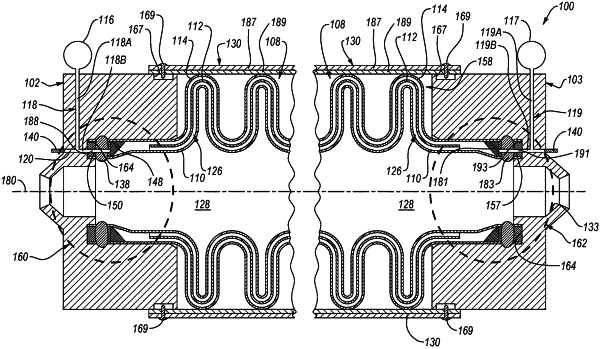| CPC F16L 5/022 (2013.01) [B21C 37/154 (2013.01); B21D 15/06 (2013.01); F16L 27/111 (2013.01); G01M 3/18 (2013.01); B21D 51/12 (2013.01); F16L 2201/30 (2013.01)] | 20 Claims |

|
1. A method (300) of fabricating a conduit (100), the method (300) comprising:
simultaneously corrugating a first tubular outboard ply (115), a second tubular outboard ply (113), inserted into the first tubular outboard ply (115), and a tubular inboard ply (111), inserted into the second tubular outboard ply (113), to form a bellows (108), comprising a central axis (180), a first corrugated outboard ply (114), a second corrugated outboard ply (112), a corrugated inboard ply (110), and an interstitial space (126), interposed between the corrugated inboard ply (110) and the first corrugated outboard ply (114), and wherein the first corrugated outboard ply (114) is formed from the first tubular outboard ply (115), the second corrugated outboard ply (112) is formed from the second tubular outboard ply (113), and the corrugated inboard ply (110) is formed from the tubular inboard ply (111);
simultaneously trimming a first corrugated-inboard-ply end (151) of the corrugated inboard ply (110) and a first first-corrugated-outboard-ply end (174) of the first corrugated outboard ply (114) to create a trimmed first corrugated-inboard-ply end (156) of the corrugated inboard ply (110) and a trimmed first first-corrugated-outboard-ply end (172) of the first corrugated outboard ply (114);
simultaneously trimming a second corrugated-inboard-ply end (163) of the corrugated inboard ply (110) and a second first-corrugated-outboard-ply end (176) of the first corrugated outboard ply (114) to create a trimmed second corrugated-inboard-ply end (170) of the corrugated inboard ply (110) and a trimmed second first-corrugated-outboard-ply end (177) of the first corrugated outboard ply (114);
locating a weld-through ring (150) between the corrugated inboard ply (110) and the first corrugated outboard ply (114) of the bellows (108) at the trimmed first corrugated-inboard-ply end (156) of the corrugated inboard ply (110) and the trimmed first first-corrugated-outboard-ply end (172) of the first corrugated outboard ply (114);
locating a second weld-through ring (157) between the corrugated inboard ply (110) and the first corrugated outboard ply (114) of the bellows (108) at the trimmed second corrugated-inboard-ply end (170) of the corrugated inboard ply (110) and the trimmed second first-corrugated-outboard-ply end (177) of the first corrugated outboard ply (114);
simultaneously attaching the trimmed first corrugated-inboard-ply end (156), the trimmed first first-corrugated-outboard-ply end (172), and the weld-through ring (150) to a first collar (102) with a first weld (138);
simultaneously attaching the trimmed second corrugated-inboard-ply end (170), the trimmed second first-corrugated-outboard-ply end (177), and the second weld-through ring (157) to a second collar (103) with a second weld (183);
forming a port (188) through the weld-through ring (150) along an axis, parallel with the central axis (180) of the bellows (108), after attaching the weld-through ring (150) to the first collar (102) with the first weld (138), so that the port (188) is communicatively coupled with the interstitial space (126);
forming a second port (191) through the second weld-through ring (157) along a second axis, parallel with the central axis (180) of the bellows (108), after attaching the second weld-through ring (157) to the second collar (103) with the second weld (183), so that the second port (191) is communicatively coupled with the interstitial space (126);
communicatively coupling a sensor (116) with the interstitial space (126) via the port (188); and
communicatively coupling a second sensor (117) with the interstitial space (126) via the second port (191) and a second channel (119) passing through the second collar (103).
|